Tōkyō Light Rail
Tōkyō has two surviving Light Rail lines, the Toden Arakawa line and the Tokyu Setagaya line. The former has an obvious heritage in “Trams”, while the latter uses larger, articulated vehicles closer in design to modern LRVs. Both lines operate over private double-track right-of-way with 600V DC power from overhead lines. Both also use high-level platforms, although perhaps not as high as a commuter train, rather the low-entrance trains. The Arakawa line has a short section of street running near Arakawa station.
Note: Kato’s Portam models, modern articulated low-level trams for street use, have no equivalent in Tōkyō. Models of Arakawa and Setagaya trams are available from Modemo, and I have a number of them, but the Portam’s are from a city (Toyama) on the other coast of the the country, but I’ve included some photos of them anyway, see below.
This page captures some typical design features of these lines.
Stations and Station Signals
Station platforms of the Arakawa line are open (presumably fares are collected on the train), with low platforms. Note that platforms are often staggered on opposite sides of a grade crossing, with the entrances to both platforms making use of the grade crossing as a pedestrian crossing, likely to avoid the expense of additional crossing gates and signals.
Both lines use outside platform stations with awnings (it rains a lot in Tōkyō during the rainy season), except for the end-of-line stations on the Setagaya line, which are single-track stations inside a building with platforms on both sides. The Arakawa line platforms are typically quite short.
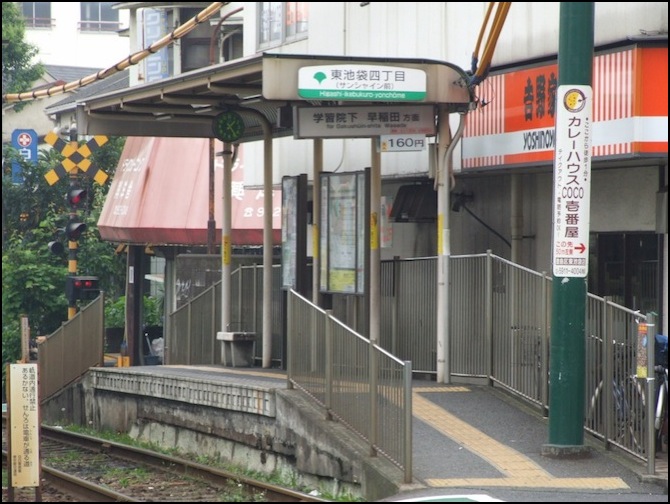
Higashi-Ikebukuro 4-chōme Stop, Toden Arakawa Line (2008)
Photographer: Lover of Romance
In the photo below, the circular black signal at the right (above the sign) is probably a grade-crossing obstruction signal, but could be the station’s “exit” signal. It’s more likely that the exit signal is the rectangular black structure above the end of the ramp closest to the platform, as the Setagaya line seems to prefer side-by-side lights for exit signals.
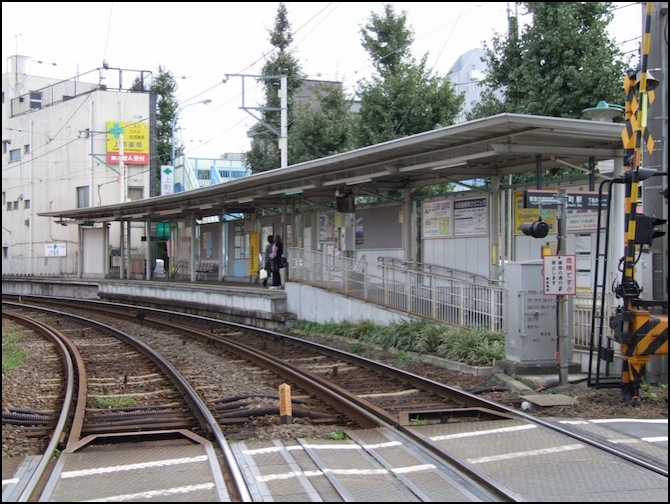
Kamimachi station, Tokyu Setagaya Line (2007)
Photographer: Lover of Romance
Signals on the Setagaya line are hard to find pictures of, however in the photo below you can just see a two color signal on the left on the far side of the grade crossing (you may need to click through to the wikipedia page and select the full-size version to make it out). Also of note are the signals with a red section above a black rectangle outlined in white. These are signals to indicate that grade-crossing protection is in place and nothing is obstructing the tracks (they display a white cross when the gates are down)
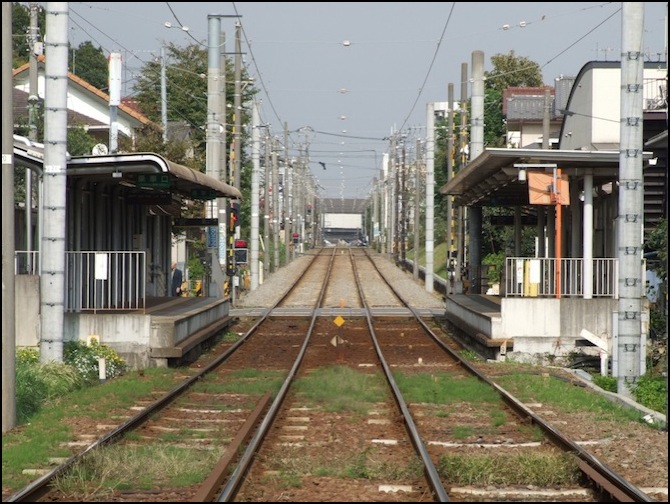
Miyanosaka station, Setagaya Line (2007)
Photographer: Lover of Romance
Signals on the Arakawa line appear to be three-color (in some cases four) typically arranged vertically with red at the top and green at the bottom, more like a highway traffic light than a typical Japanese railway signal (which more commonly places red at the top), although I have seen other lines where green was placed on the bottom. Except that Japanese highway lights are arranged horizontally (I did spot one three-color horizontal signal on the Arakawa line, likely oriented that way due to space constraints). It’s possible that the four-color signals are “entrance” signals, and the three-color ones are “exit” signals. I’m suspicious that the Arakawa line may not have signaling at all, and these are merely street signals.
In the first photo below, the signal between the tracks is almost certainly the “exit” signal for the left-hand track, since trains run on the left in Japan. The signal to it’s right, facing the other way would be the “exit” signal” for the platform across the street on the right-hand track. Normally both signals would be placed outside the tracks, but the combination of a curve and tight space probably didn’t leave room for a post between the rails and the station entrance ramp.
Note that these two crossing don’t have gates. The signals may simply be part of a traffic-light system used on the road, to tell the train when it has right-of-way across the street, and not part of a railway signaling system.
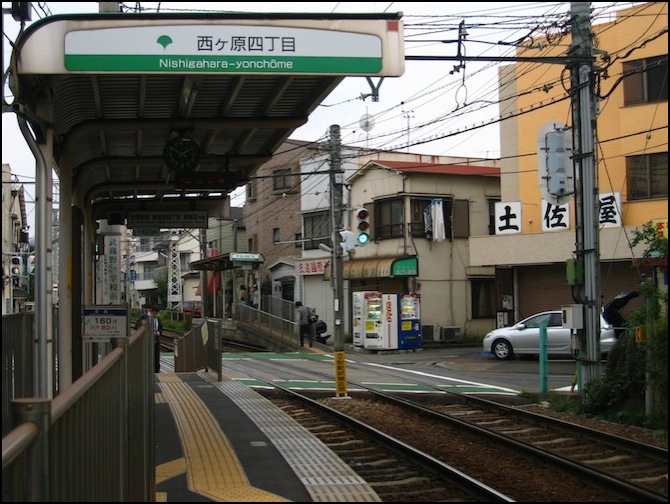
Toden Arakawa Line,Nishigahara Yonchōme Station (2007)
Photographer: Sidecoast
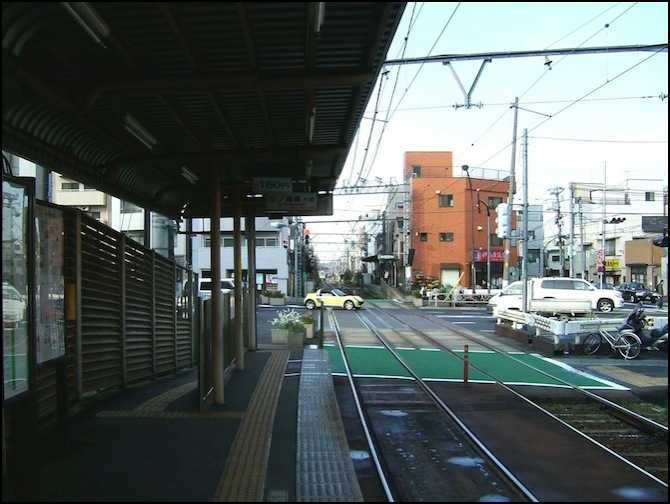
Shin-Koshinzuka Station, Toden Arakawa Line (2008) - note three-color signals
Photographer: LERK
The photo below shows four-color signals. This type is sometimes used to display a “slower than caution” yellow-over-yellow indication, possibly because the grade crossing does not appear to have gates. Note that the signal adjacent to the platform on the left has a duplicate just visible on the far left. This is likely a “repeater” showing the same signal, so a “stop” can be seen even if a truck is blocking the tracks. While these could be street signals for cars, they’re on the wrong side of the road, and the overhead signal has only three lights where these have four, plus there’s the one on the far right that’s obviously not facing a road, making it more likely that these are for the railway, although they could still be part of a system including the street signals, to allow trams and cars to take turns.
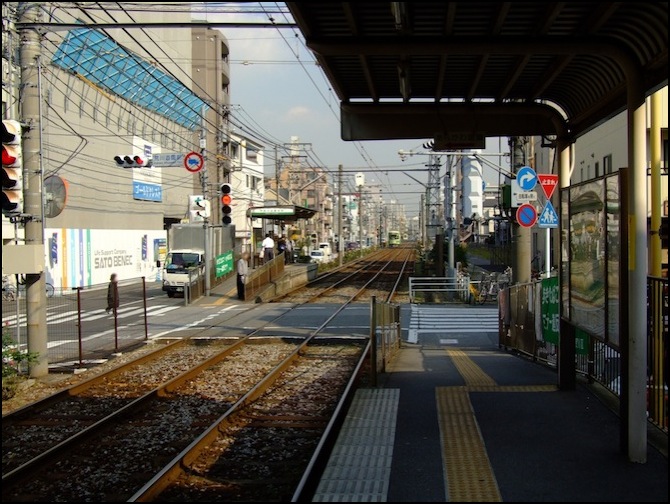
Arakawa yuenchimae (Arakawa playland) station, Toden Arakawa Line (2006) - note four-color signals, and repeater (far left)
Photographer: LERK
The Arakawa line doesn’t appear to have signals everywhere. In the photo below any departure signal should be near this end of the platform (unless it’s between the tracks or just behind the photographer). And in the second photo (same station, other platform) there are no obvious entrance or exit signals. However, I examined the grade crossing using Streetview, and saw a two-head signal with what appears to be an “X” on the lower head and a vertical line or arrow on the upper facing each way at the street. This may simply be a grade crossing signal (the “X” is typical of those, although I’ve never seen this form before), but it could be the station exit signal also.
Although it’s not obvious from these photos, this particular grade crossing does have gates, which may be why it is done differently.
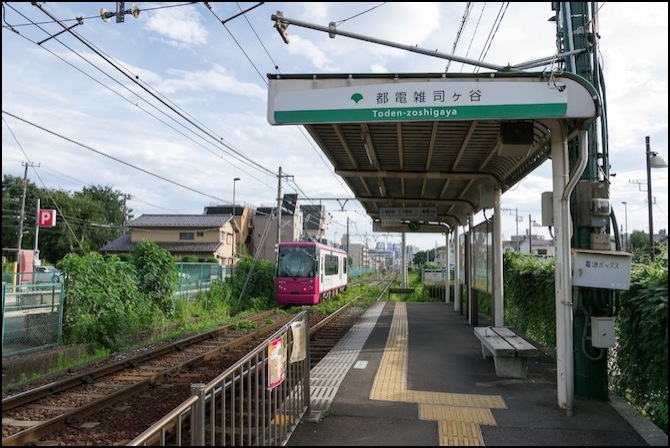
Zoshigaya station, Arakawa Line (2012)
Photographer: Rs1421
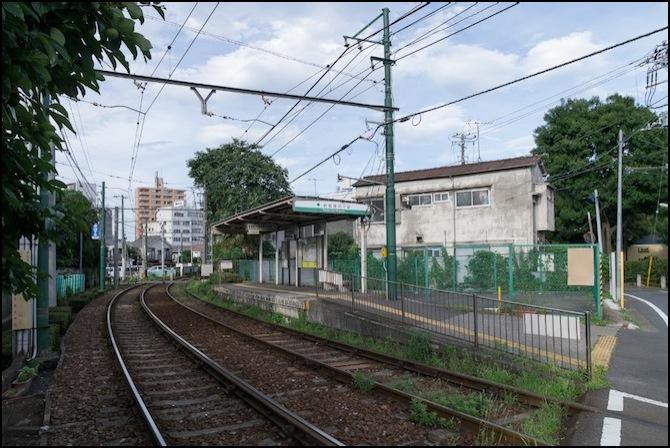
Zoshigaya station, Arakawa Line (2012)
Photographer: Rs1421
Perhaps more reflective of what one would expect in a light rail line is the Toyama Light Rail Toyamakō Line, home of the “Portram” (short for Port Tram) articulated light rail vehicles produced by Kato and Tomytec. These are low-floor vehicles, so their stations are also low level. The line is mostly single-track, with a mix of street-running and back-of-building private right of way, but some stations are double-track to allow passing. Interestingly, where the right of way is not paved, in some cases it appears to be dirt filled and planted with grass, perhaps to make it easier for pedestrians to cross, or to discourage pedestrians since it looks like a well-maintained lawn.
Note that this is not a Tōkyō-area line, being located on Japan’s opposite, Sea of Japan, coast, about 200 miles away.
The line appears to use conventional lineside signals where there are switches, and these may function as block signals also since there’s single-track line between them. But the lack of any visible equivalent at Toyamaeki-kita Station makes we question that.
These first three photos show the end of the line downtown, at Toyamaeki-kita Station, adjacent to the JR Toyama Station. Although the station is double-tracked, the line becomes single track almost immediately. The third photo shows a traffic-light style signal displaying a red “X” on the station side of the adjacent road, which may be to prevent trams from crossing the street until the light changes (per Google Streetview there’s a matching one on the other side of the road, controlling trams leaving the station). There is no obvious station-exit or block signal, although further down the street there is a four-head traffic-light style signal (also displaying a red “X”) controlling trains headed towards the station (perhaps a “distant” signal for the crossing).
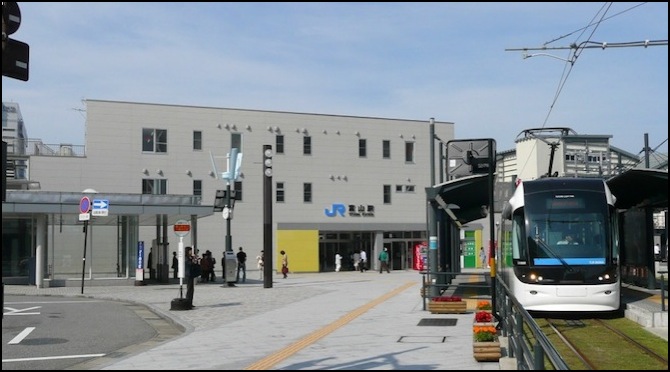
Toyama Station North Exit (2007)
Photographer: UE-PON2600
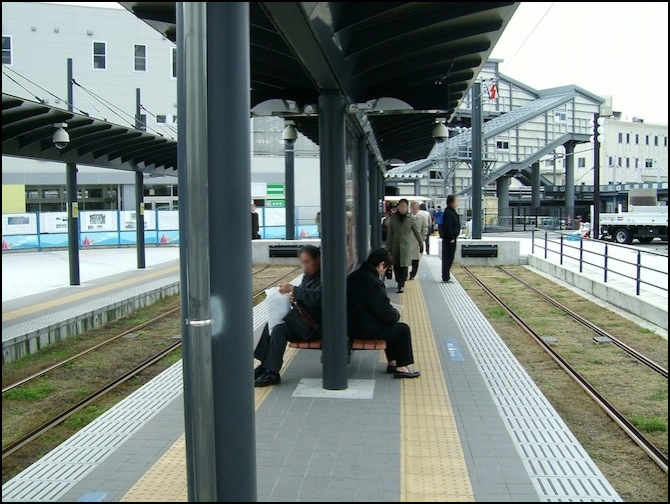
Toyamaeki-kita Station (2007)
Photographer: LERK
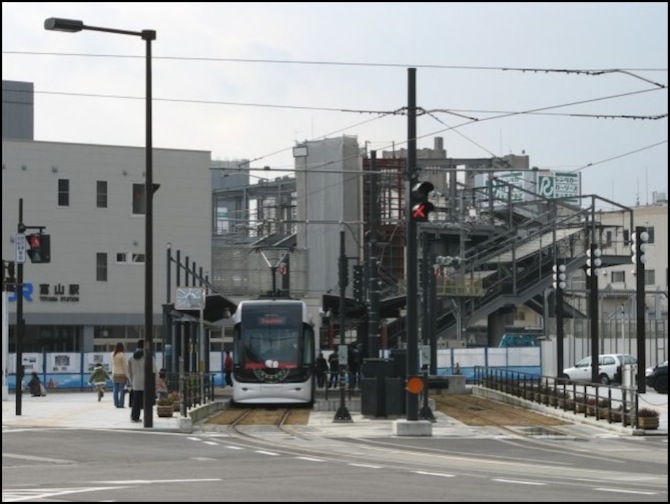
Toyamaeki-kita Station (2006)
Photographer: GAMEGAWA
In the photo below, the tram on the left would be headed away from the photographer. Note the back of the station departure signal on the right, likely there to prevent a train from departing until any approaching train has entered the station.
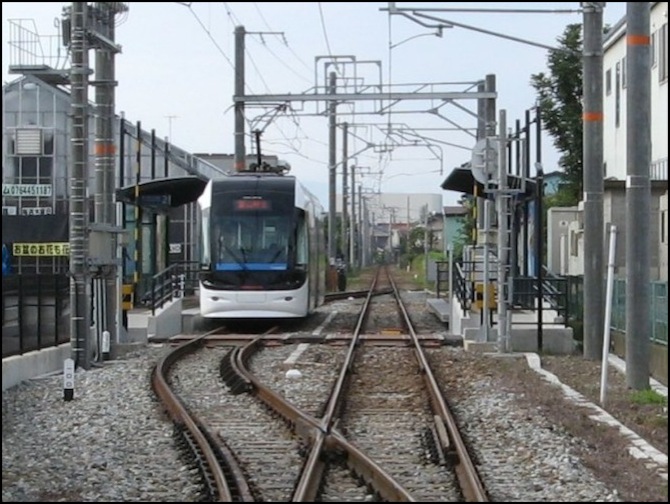
Awashima (or Awajima) Station (2007)
Photographer: GAMEGAWA
Although the photo below isn’t of a station, it appears to be taken from a station and shows the backside of a signal head guarding the switch that can just be seen in the foreground. You can also see he yellowish dwarf position signal on the left (technically a “white” signal, I believe) displaying “stop” (horizontal lights) because the switch is set against it and there is a train approaching). You can also see a track obstruction
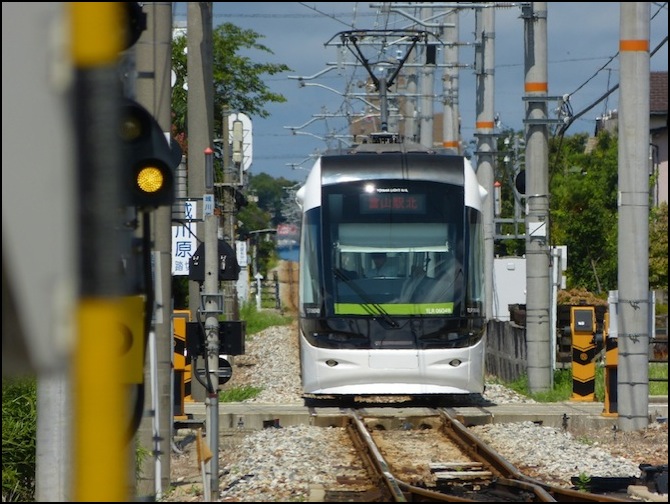
Toyama Light Rail TLR0600 form (2012)
Photographer: Hisagi
The photo below, enlarged from a larger panorama, shows the station platform design and the position of the exit signal somewhat better.
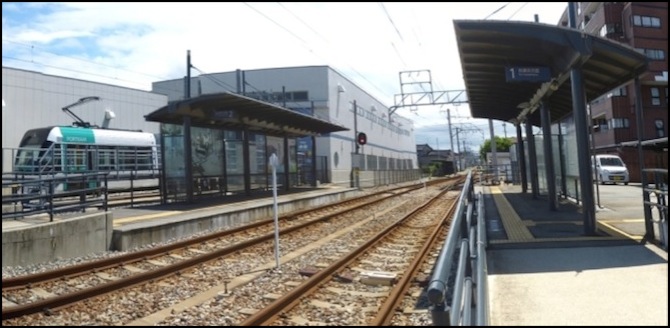
Toyama Light Rail Jōgawara Station (2012)
Photographer: Hisagi
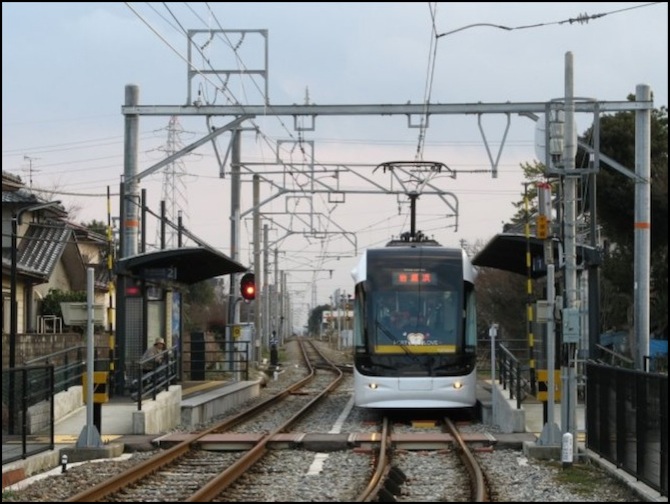
Ohirota Station (2007)
Photographer: GAMEGAWA




